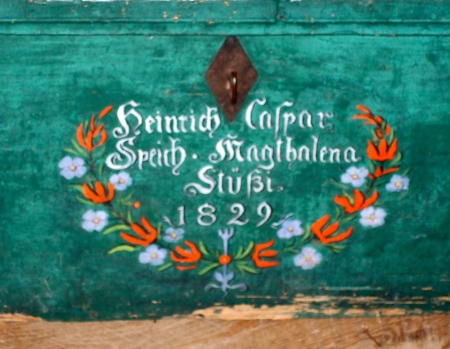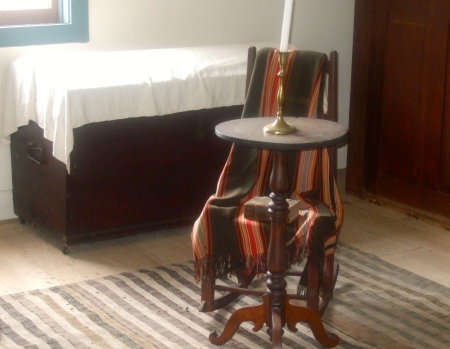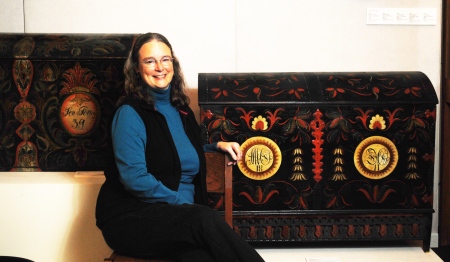 Heritage of Darkness, the 4th Chloe Ellefson mystery, was the first to cross state lines. It’s set at Vesterheim Norwegian-American Museum in Decorah, Iowa.
Heritage of Darkness, the 4th Chloe Ellefson mystery, was the first to cross state lines. It’s set at Vesterheim Norwegian-American Museum in Decorah, Iowa.
By the time I started planning this book I’d visited this wonderful museum while writing the first Chloe mystery, Old World Murder, to study ale bowls. I’d also taken several classes through the museum’s folk art school.

Me with my first rosemaling instructor, Gold Medalist Joanne MacVey

I also learned the basics of Danish hedebo embroidery (featured in The Lightkeeper’s Legacy) at Vesterheim. Here instructor Roger Buhr explains motif construction.
I’d enjoyed my own class experiences so much I wanted to feature that element in the book. I also love Vesterheim’s annual Norwegian Christmas celebration, and decided to feature that as well.

Most importantly, this setting provided the opportunity to develop characters in new ways. A road trip to Vesterheim, where Chloe and her mom take rosemaling classes (Chloe is a beginner; Mom, advanced), let me explore a complicated mother-daughter relationship.
Also, at the end of Book 3, Chloe and Roelke have reached an understanding. They are a couple, and both want to see where their relationship might go. Having Roelke volunteer to come on the trip let their relationship develop as well.
SPOILER ALERT: Plot points discussed below!
A mystery writer is always looking for ways to get characters in trouble, and for situations that might foster conflict. I was familiar with the old adage, Beware the man with many mangles, which referred to the tradition of men carving a mangle board for the woman he hoped to marry. If a mangle was refused, it could not be offered to another woman. How could I not use that bit of folk wisdom? Thus Emil was born.

This is a mangle board I painted as a class project.
I also decided to focus on some ancient winter customs. In the pre-Christianity days, many in northern Europe believed December’s shortest, darkest days brought evil spirits swooping through the sky. People developed traditions to help ward away the evil. By the time Christian Norwegian immigrants came to the Midwest, those traditions had evolved, but still persisted in the form of julebukking. Since the book came out I’ve talked to many people who remember disguising their identity with a costume and going out to visit neighbors.

This reproduction in the Vesterheim collection represents the Christmas goat. In ancient times a goat head, real or effigy, was used to ward away evil.
That offered some interesting possibilities for a mystery plot! The whole notion of having a chance to act up led to the scene near the story’s end, which takes place in Vesterheim’s Open-Air Division:
The julebukker whipped something from behind his back and shoved it toward her. Chloe glimpsed glowing animal eyes, wicked animal teeth, wildly streaming animal hair—all evoking the childhood memory of the threatening strangers brandishing a bloody goat head on a stick.
…Chloe tried again to wrench away from the devil-creature. Her boots slipped over the drop-off beside the house. The julebukker swung her hard, like a mean child playing crack-the-whip, and released her abruptly. Chloe flew head-first toward the home’s stacked-stone foundation.
My working title for the book was The Power of Darkness, harkening back to those old times. My publisher changed it to Heritage of Darkness to get a “history” word in the mix, a trend which had been established in the first three books. (Old, Heirloom, Legacy.) I trust my many Norwegian friends know the sentiment isn’t personal!
I also trust that my many rosemaling friends know how I admire their work, and how much I enjoy painting myself—even though I have no innate aptitude.

I am always the slowest painter in any class. I think just about everyone else had left for the day when this picture was taken.
Chloe has a miserable time in her rosemaling class, but I wanted to leave open the possibility that some of her challenges stemmed from her own preconceived ideas. This led to one of my favorite moments in the story:
“Do you know what I have loved most about rosemaling?” Mom asked.
“Winning your Gold Medal.”
“No.” Mom stared at Chloe’s tray, but her gaze had turned inward. “Every time I pick up a brush, I feel connected to the old days when skilled painters traveled through Norway’s remote valleys. Rosemaling was done in the winter, so the artists probably traveled by sleigh, or perhaps just on skis. I picture isolated families welcoming the rosemaler into their dark little cabins—back in the days when most people lived in windowless houses with just an open hearth to provide warmth and light. Can you imagine what a joy it would be to have the painter at work while snow fell and wind howled? Can you imagine how people felt while watching the painter bring such vivid life and color to their world during winter’s bleakest, darkest days?”
“Well…I can now,” Chloe allowed.
A small step forward for Mom and Chloe.
By this point in the series, some readers were asking if/when Chloe and Roelke’s relationship would become intimate. Since this is a Traditional mystery, with no explicit sex or gore, I crafted a scene that I hoped conveyed the moment without spelling it out. Perhaps I should have been a wee bit more explicit, because I heard from a couple of people who’d read the book and were still wondering when the two main characters would have sex.

My talented friend Ellen Macdonald made this chip carved candle plate to represent the gift Roelke gave to Chloe, used in the hotel scene.
I also heard from a reader who complained about my sloppy writing, referring to the fact that about mid-book, I repeated a thought. Chloe and Roelke are, in their separate lodgings, going to bed. First Roelke thinks:
Tonight, with a killer wandering Decorah and a December wind rattling the windows, he really, really wished he could fall asleep with Chloe in his arms.
In a later scene, in Chloe’s point of view, she has the same thought:
Tonight, with a killer wandering Decorah and a December wind rattling the windows, she really, really wished she could fall asleep in Roelke’s arms.
I crafted that echo in hopes it would convey the growing bond between them; how they both wanted the same thing; that they were connected in thought even if physically apart. One never knows how such things might strike any individual reader.
While Chloe and Roelke’s relationship took a big step forward, Chloe’s relationship with Mom is only somewhat improved. I could have wrapped the book up with some moment of complete harmony and understanding between the two women, but it would have felt—at least to me—too pat and unrealistic.
What did you think?
You can explore relevant people, places, and the past on my webpage for Heritage of Darkness. Resources include a Google map, color images of key artifacts, a Discussion Guide, a recipe for Chloe’s Tomato Soup, and links to lots of additional background material.
A final thought: People often ask how employees feel about me setting a murder mystery at their historic site or museum. I always chat with key staff before starting a new book, and make sure everyone is comfortable with the idea. The staff and volunteers at Vesterheim have been wonderful, and Mr. Ernst and I have made many friends within the Norwegian-American community. (We even celebrated our 20th wedding anniversary in Norway!) The decision years ago to create a protagonist of Norwegian descent has brought wonderful things we couldn’t have imagined. We’re grateful.


















 Mr. Ernst here. This month the focus is on a surprise that turned up when researching a specific scene in this book, the fourth in Kathleen’s award-winning
Mr. Ernst here. This month the focus is on a surprise that turned up when researching a specific scene in this book, the fourth in Kathleen’s award-winning 












































































